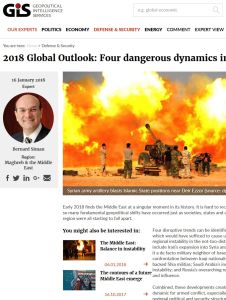Join getAbstract to access the summary!

Join getAbstract to access the summary!
Bernard Siman
2018 Global Outlook: Four dangerous dynamics in the Middle East
GIS, 2018
What's inside?
Four recent trends in the Middle East make the region particularly volatile in the near term.
Recommendation
Middle Eastern politics are notoriously complex and unpredictable. This holds especially true in 2018, as domestic unrest, shifting alliances, armed bloodshed and foreign meddling redefine the dynamics in nations such as Syria, Yemen and Iraq. Strategic risk analyst and investment adviser Bernard Siman identifies four regional trends he thinks will prove most consequential in the near term. Based on these trends, he outlines several future-looking scenarios in a report written for the Lichtenstein-based Geopolitical Intelligence Services (GIS).
Summary
About the Author
Bernard Siman is a strategic risk analyst advising investors and insurance operators from the Gulf, Japan and Europe.
















Comment on this summary